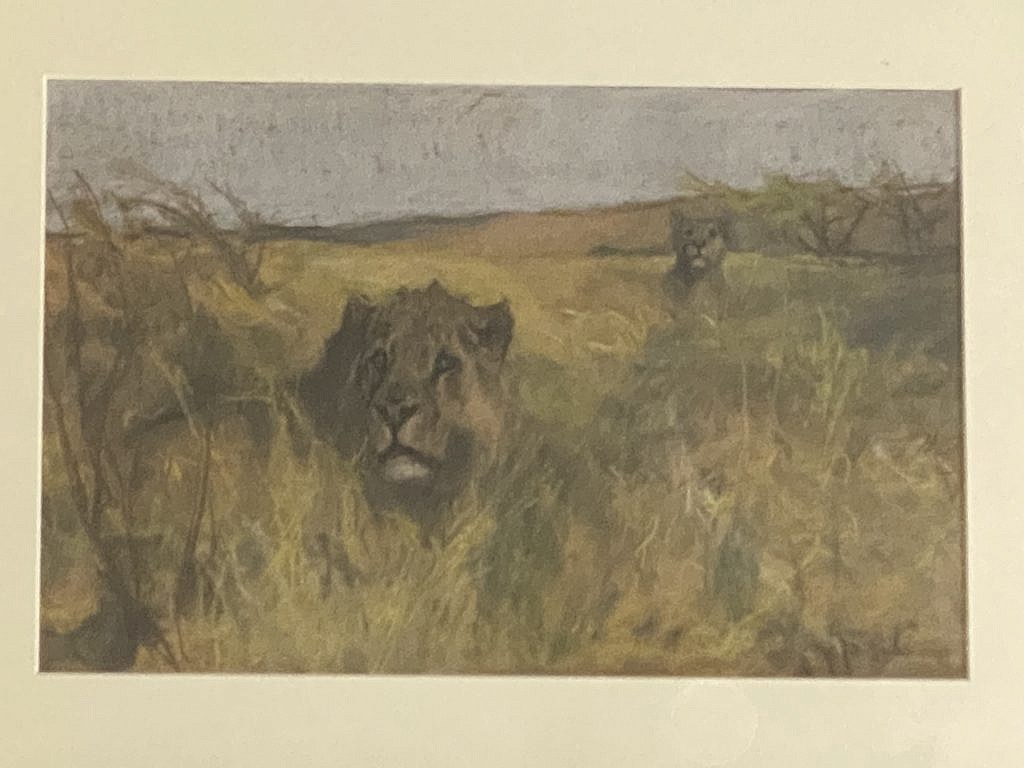
by Brooke Chilvers
After nine months away from “home,” in a village in Brittany not 15 kms from my husband’s family’s cemetery plot, vaccinated American spouses with negative Covid-19 tests were finally allowed to board the Air France flight to Paris.
The sun was shining when we arrived, but hélas, the car battery was dead. All problems solved after a “well-watered” lunch whose ingredients, including lapin, would make my sister-in-law shutter.
Setting off for the five-hour drive after the Friday market, with five cheeses, fresh salted butter, quail brochettes, and a single perfect rabbit liver, we arrived – three months late – to our overgrown, fly-spackled cottage, and one surviving goldfish.
What joy when I saw my two favorite paintings on this side of the pond, both by self-taught, London-born artist Arthur Wardle (1864–1949), who’d started painting purebred dogs around 1887. His first was likely that of breeder Francis Redmond’s d’Orsay smooth fox terriers, painted for dog breeder, judge and author Frederic Mansell, who wrote show reports for The Field and Our Dogs magazines.
After Wardle exhibited at the reputedly first dog-art show in London in 1901, Mansell began publishing limited-print runs of Wardle’s paintings. His well-known pointer portrait, Champion Coronation, became the engraving A Pointer of the Twentieth Century; the edition also included 75 black and white artist’s proofs, plus 30 more in color, each costing twice or three times as much as the 21-shilling prints.

Mansell then commissioned Wardle for a series of 30 portraits of the era’s outstanding show dogs, including the two famous Airedale terriers owned and bred by Mrs. Holland Buckley, author of the first book on the breed. The delightful original hangs in the AKC Museum of the Dog in New York City.
Mansell marketed Wardle’s dog engravings through the hunting press and at dog shows until he sold the plates, in 1924, to Spratt’s Patent, Ltd., the world’s first large-scale manufacturer of dog biscuits. Spratt’s republished them, along with 36 collectible postcards with sepia images of Wardle’s dogs, selling them at their stand at Crufts.
Wardle’s simple pencil or ink portraits and ornamental vignettes of dogs also generously illustrated the books by Rawdon Lee, editor of The Field, including his 1893-94 series, A history and description of the modern dogs of Great Britain and Ireland.
Starting in 1911, the weekly periodical Our Dogs ran a series on the ideal of every breed, illustrated by Wardle’s pen and ink drawings. All 92 were collected into the 1926 book, Show Dogs, intended to provide breeders with a clear standard to breed to. The general opinion was that a Wardle illustration was superior to a photograph in demonstrating important conformation characteristics.
From 1924 to 1940, Wardle made 250 paintings of dogs, probably in five sets of 50, for WH & HO Wills and John Player & Sons cigarettes. Each set required a new treatment. For example, in 1924 for Player, colorful backgrounds set the tone; in 1937, it was full-bodied profiles of show poses; and in 1939, it was two differently oriented silhouetted head shots.
Whether an original composition, a commission, a book illustration, or an advertisement, Wardle painted virtually every dog breed in England. Yet neither of my two works – purchased from dog-art gallerist and expert William Secord in the early 21st century – are of dogs!
In fact, from age 16 to 75, Wardle exhibited 113 paintings at the Royal Academy, 29 at the Society of British Artists, and several dozen at two late-life one-man shows. Yet none of these works focused on purebred dogs.
My two pastels are of a pair of tawny lions hiding in the African savanna, and free-spirited polar bears swimming in the sea.
I can picture Wardle drawing them after he moved his family to leafy St. John’s Wood, six minutes on foot from the London Zoo where he sketched wild animals year round and in all weathers, until he knew their every mood and muscle. Which explains my long-term love affair with these two paintings.
______________________________________________________________________________
By the time this blog is posted, the three welcome days of sunshine in Brittany will have evolved into two weeks of steady rain. Welcome home.
